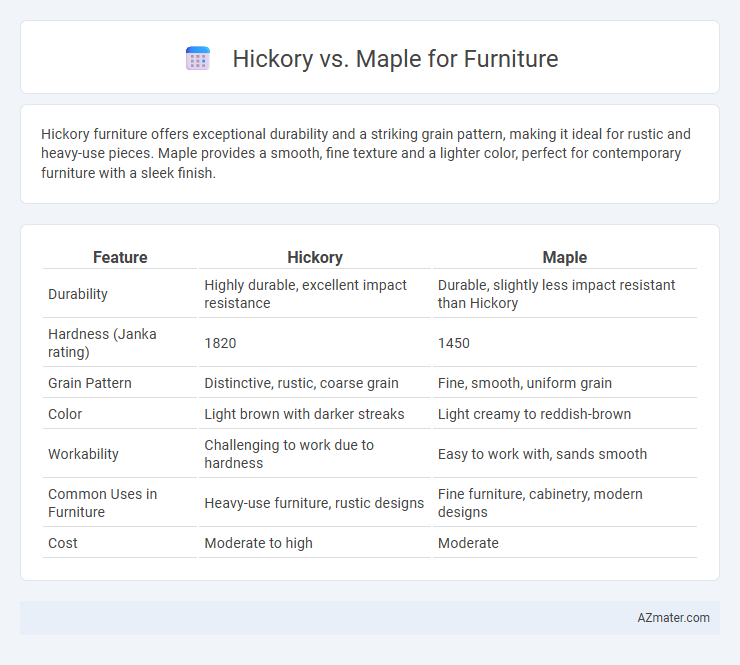Hickory furniture offers exceptional durability and a striking grain pattern, making it ideal for rustic and heavy-use pieces. Maple provides a smooth, fine texture and a lighter color, perfect for contemporary furniture with a sleek finish.
Table of Comparison
| Feature | Hickory | Maple |
|---|---|---|
| Durability | Highly durable, excellent impact resistance | Durable, slightly less impact resistant than Hickory |
| Hardness (Janka rating) | 1820 | 1450 |
| Grain Pattern | Distinctive, rustic, coarse grain | Fine, smooth, uniform grain |
| Color | Light brown with darker streaks | Light creamy to reddish-brown |
| Workability | Challenging to work due to hardness | Easy to work with, sands smooth |
| Common Uses in Furniture | Heavy-use furniture, rustic designs | Fine furniture, cabinetry, modern designs |
| Cost | Moderate to high | Moderate |
Introduction to Hickory and Maple Furniture
Hickory furniture is renowned for its exceptional hardness, durability, and striking grain patterns, making it a popular choice for rustic and country-style pieces. Maple furniture offers a smooth, fine grain with high strength and a lighter, uniform color that suits modern and contemporary designs. Both woods provide excellent wear resistance and longevity, but their distinct aesthetics and hardness levels cater to different stylistic preferences and functional needs in furniture making.
Wood Characteristics: Hickory vs Maple
Hickory wood is known for its exceptional hardness, density, and shock resistance, making it highly durable for heavy-use furniture, while its distinct grain pattern adds a rustic character. Maple wood features a smooth, fine grain with a lighter color, offering excellent stability and resistance to abrasion, ideal for sleek, modern furniture designs. Both woods are close in hardness on the Janka scale, with hickory around 1820 and hard maple about 1450, influencing their suitability for different furniture aesthetics and longevity.
Strength and Durability Comparison
Hickory wood is renowned for its exceptional hardness and shock resistance, making it one of the strongest domestic hardwoods ideal for heavy-use furniture. Maple offers impressive durability with a fine, consistent grain and high resistance to abrasion, making it perfect for surfaces that require smooth finishing and longevity. Comparing the two, hickory excels in impact strength and toughness, while maple provides superior stiffness and wear resistance, catering to varying durability needs in furniture construction.
Appearance and Grain Patterns
Hickory furniture showcases a striking contrast with its bold, irregular grain patterns and rich color variations ranging from creamy white to dark brown, creating a rustic, rugged aesthetic. Maple offers a smooth, consistent grain with subtle patterns and a lighter, creamy color that ages to a warm amber tone, perfect for modern or traditional designs. The contrast in grain depth and color intensity makes hickory ideal for statement pieces, while maple suits sleek, minimalist furniture styles.
Workability and Craftsmanship
Hickory offers exceptional workability with its dense grain, allowing intricate carving and detailed craftsmanship, though it requires sharp tools and careful handling due to its hardness. Maple, especially hard maple, is prized for its smooth, even grain which enables precise cutting and fine finishes, making it a favorite for high-quality furniture production. Both woods provide durable surfaces, but maple's consistent texture simplifies sanding and staining for superior aesthetic results in furniture making.
Finishing and Staining Differences
Hickory wood features a coarse grain with natural color variations, making it ideal for rustic finishes that highlight its knots and sapwood contrast, while maple has a fine, consistent grain that provides a smooth surface perfect for even staining and a uniform appearance. Hickory's dense and oily nature can make staining challenging, often requiring pre-treatment or gel stains to achieve deeper, rich tones, whereas maple readily absorbs stains, allowing for a wide range of color options from light to dark finishes. The choice between hickory and maple for furniture finishing and staining ultimately depends on the desired aesthetic, with hickory offering a more textured, rugged look, and maple delivering a clean, polished finish.
Cost and Value Considerations
Hickory furniture is generally more affordable than maple, offering excellent durability and a rustic aesthetic that appeals to budget-conscious buyers seeking long-lasting pieces. Maple furniture, while typically more expensive, delivers superior hardness, smooth grain, and a refined appearance that adds higher perceived value and elegance to interiors. Choosing between hickory and maple depends on balancing initial cost against long-term wear and style preferences, with maple often providing greater resale value due to its premium qualities.
Environmental Impact and Sustainability
Hickory and maple both rank highly in sustainability due to their abundance and regenerative growth rates, but maple tends to have a lower environmental impact because it grows more quickly and requires less intensive harvesting methods. Hickory's denser, slower-growing nature can lead to more resource-heavy processing and longer forest recovery times compared to maple. Choosing maple furniture supports sustainable forestry practices by promoting efficient land use and reducing carbon emissions associated with harvesting and transport.
Best Furniture Types for Hickory and Maple
Hickory is best suited for rustic and country-style furniture such as dining tables, chairs, and benches due to its exceptional strength, shock resistance, and distinctive grain patterns. Maple excels in crafting fine furniture pieces like cabinets, dressers, and flooring because of its smooth texture, durability, and light, uniform color that takes stain evenly. Both woods offer unique advantages, with hickory prioritizing toughness and maple favoring versatility and a refined finish.
Choosing the Right Wood for Your Furniture
Hickory offers exceptional durability and shock resistance, making it ideal for high-traffic furniture like chairs and tables, while maple provides a smooth grain and consistent texture, perfect for refined pieces such as dressers and cabinetry. The dense hardness of hickory results in a more rustic appearance that ages well, contrasting with maple's lighter, more uniform finish that enhances contemporary styles. Selecting between hickory and maple depends on the desired balance of strength, aesthetics, and maintenance in your furniture design.

Infographic: Hickory vs Maple for Furniture
 azmater.com
azmater.com